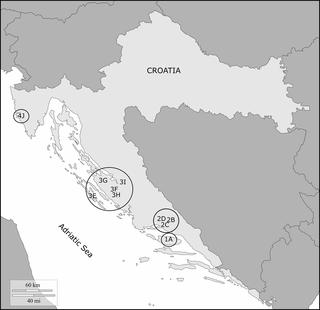当前位置:
X-MOL 学术
›
PLOS Negl. Trop. Dis.
›
论文详情
Our official English website, www.x-mol.net, welcomes your
feedback! (Note: you will need to create a separate account there.)
Anisakis Sensitization in the Croatian fish processing workers: Behavioral instead of occupational risk factors?
PLOS Neglected Tropical Diseases ( IF 3.4 ) Pub Date : 2020-01-27 , DOI: 10.1371/journal.pntd.0008038 Ana Jerončić 1 , Diana Nonković 2 , Anamarija Vrbatović 3 , Jerko Hrabar 3 , Ivana Bušelić 3 , Victoria Martínez-Sernández 4 , Santiago A Lojo Rocamonde 5 , Florencio M Ubeira 4 , Sonja Jaman 6 , Esma Čečuk Jeličić 6 , Marco Amati 7 , Maria Angeles Gomez Morales 7 , Boris Lukšić 6 , Ivona Mladineo 3
PLOS Neglected Tropical Diseases ( IF 3.4 ) Pub Date : 2020-01-27 , DOI: 10.1371/journal.pntd.0008038 Ana Jerončić 1 , Diana Nonković 2 , Anamarija Vrbatović 3 , Jerko Hrabar 3 , Ivana Bušelić 3 , Victoria Martínez-Sernández 4 , Santiago A Lojo Rocamonde 5 , Florencio M Ubeira 4 , Sonja Jaman 6 , Esma Čečuk Jeličić 6 , Marco Amati 7 , Maria Angeles Gomez Morales 7 , Boris Lukšić 6 , Ivona Mladineo 3
Affiliation

|
We undertook the first study systematically evaluating the risk of Anisakis-sensitization in Croatian fish-processing workers and potential genetic susceptibility to anisakiasis. Anti-Anisakis IgE seroprevalence and risk factors for 600 employees of Croatian fish processing facilities and 466 blood donor controls, were assessed by indirect ELISA targeted with: recombinant Ani s 1 and Ani s 7 allergens, an Anisakis crude extract, the commercial ImmunoCAP kit, and questionnaires. Genetic susceptibility to anisakiasis was evaluated by genotypisation of human leukocytes alleles (HLA). Anti-Anisakis seropositive and a fraction of negative subjects were also assessed by ELISA and Western Blot (WB) for IgG seroprevalence to Trichinella spp. Overall, the observed anti-Anisakis seroprevalence inferred by indirect ELISA was significantly higher in fish processing workers (1.8%, 95% CI 0.9-3.3%) compared to the controls (0%, 0-0.8%). Seven out of 11 Ani s 1 and Ani s 7-positives and none of selected 65 negative sera, tested positive on whole-Anisakis extract (ImmunoCAP), whereas Anisakis crude extract ELISA detected 3.9% (2.4-6.0%) seropositives in fish processing workers, three (14%) of which showed IgE reactivity to milk proteins. The highest risk associated with Anisakis-sensitization among workers was fishing in the free time, rather than any of attributes related to the occupational exposure. Although no association was observed between anti-Anisakis seropositivity and wearing gloves or protective goggles, the majority of workers (92%) wore protective gloves, minimizing the risk for Anisakis sensitization via skin contact. Six HLA alleles within DRB1 gene were significantly associated with seropositivity under dominant, allelic or recessive models. All sera confirmed negative for anti-Trichinella spp. IgG. The study exhaustively covered almost all marine fish processing workers in Croatia, reflecting real-time Anisakis sensitization status within the industry, already under the influence of wide array of allergens.
中文翻译:

克罗地亚鱼类加工工人的Anisakis过敏症:行为危险因素而非职业危险因素?
我们进行了第一项研究,系统地评估了克罗地亚鱼类加工工人对Anisakis致敏的风险以及对Anisakiasis的潜在遗传易感性。通过间接ELISA评估了600名克罗地亚鱼类加工设施和466名献血者的雇员的抗茴香酸IgE血清阳性率和危险因素,针对的目标是:重组Ani s 1和Ani s 7过敏原,Anisakis粗提取物,商业ImmunoCAP试剂盒,和问卷。通过对人类白细胞等位基因(HLA)进行基因分型来评估对茴香的遗传易感性。还通过ELISA和Western Blot(WB)对抗旋毛虫血清阳性和一部分阴性受试者的IgG血清阳性率进行了Trichinella spp评估。总体,与对照组(0%,0-0.8%)相比,通过间接ELISA推断的观察到的抗茴香脑血清阳性率在鱼类加工工人中(1.8%,95%CI 0.9-3.3%)明显更高。在11个Ani s 1和Ani s 7阳性中有7个,在选定的65个阴性血清中均未检测到全茴香提取物(ImmunoCAP)呈阳性,而Anisakis粗提取物ELISA在鱼类加工中检测到3.9%(2.4-6.0%)血清阳性工人,其中三名(14%)对牛奶蛋白表现出IgE反应性。在工人中,与Anisakis致敏有关的最高风险是在业余时间钓鱼,而不是与职业暴露有关的任何属性。尽管未发现抗茴香胺菌的血清阳性与戴手套或护目镜之间存在关联,但大多数工人(92%)戴着防护手套,尽量减少通过皮肤接触Anisakis致敏的风险。在显性,等位基因或隐性模型下,DRB1基因内的六个HLA等位基因与血清阳性呈显着相关。所有血清均证实抗旋毛虫属阴性。IgG。这项研究详尽地涵盖了克罗地亚几乎所有的海鱼加工工人,反映了该行业中已经受到多种过敏原影响的实时Anisakis致敏状况。
更新日期:2020-01-29
中文翻译:

克罗地亚鱼类加工工人的Anisakis过敏症:行为危险因素而非职业危险因素?
我们进行了第一项研究,系统地评估了克罗地亚鱼类加工工人对Anisakis致敏的风险以及对Anisakiasis的潜在遗传易感性。通过间接ELISA评估了600名克罗地亚鱼类加工设施和466名献血者的雇员的抗茴香酸IgE血清阳性率和危险因素,针对的目标是:重组Ani s 1和Ani s 7过敏原,Anisakis粗提取物,商业ImmunoCAP试剂盒,和问卷。通过对人类白细胞等位基因(HLA)进行基因分型来评估对茴香的遗传易感性。还通过ELISA和Western Blot(WB)对抗旋毛虫血清阳性和一部分阴性受试者的IgG血清阳性率进行了Trichinella spp评估。总体,与对照组(0%,0-0.8%)相比,通过间接ELISA推断的观察到的抗茴香脑血清阳性率在鱼类加工工人中(1.8%,95%CI 0.9-3.3%)明显更高。在11个Ani s 1和Ani s 7阳性中有7个,在选定的65个阴性血清中均未检测到全茴香提取物(ImmunoCAP)呈阳性,而Anisakis粗提取物ELISA在鱼类加工中检测到3.9%(2.4-6.0%)血清阳性工人,其中三名(14%)对牛奶蛋白表现出IgE反应性。在工人中,与Anisakis致敏有关的最高风险是在业余时间钓鱼,而不是与职业暴露有关的任何属性。尽管未发现抗茴香胺菌的血清阳性与戴手套或护目镜之间存在关联,但大多数工人(92%)戴着防护手套,尽量减少通过皮肤接触Anisakis致敏的风险。在显性,等位基因或隐性模型下,DRB1基因内的六个HLA等位基因与血清阳性呈显着相关。所有血清均证实抗旋毛虫属阴性。IgG。这项研究详尽地涵盖了克罗地亚几乎所有的海鱼加工工人,反映了该行业中已经受到多种过敏原影响的实时Anisakis致敏状况。


















































 京公网安备 11010802027423号
京公网安备 11010802027423号